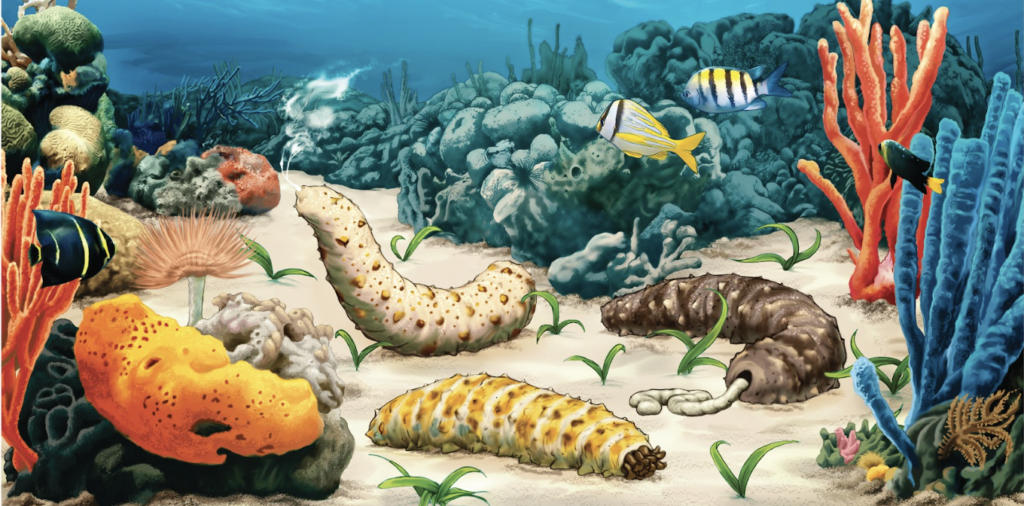Beneath the serene depths of the ocean lies a world teeming with life, where the unassuming sea cucumber thrives. Often overlooked, but integral to the ocean’s delicate balance.

1. Ingenious Defense Mechanisms
Sea cucumbers boast an extraordinary defense strategy. Certain species possess the unique ability to expel their internal organs when attacked. This provides the predator with something else to eat, and a few weeks later the sea cucumber has grown new intestines and respiratory organs. Some sea cucumbers have evolved sticky, toxic, string-like organs grown specifically for this purpose.
2. Remarkable Respiratory Adaptations
Unlike most marine creatures that rely on gills for breathing, sea cucumbers employ an unconventional respiratory method. Through specialized structures known as respiratory trees, connected to their cloaca situated at the anus, these creatures extract oxygen from water and expel carbon dioxide. Effectively, they breathe through their derriere, a fascinating biological adaptation.
3. Culinary Elegance
Believe it or not sea cucumber is one of the most expensive and sought after foods in East Asia, going for as much as $3,500 a kilo. Chinese, Japanese, and Korean cuisines, among others, feature sea cucumbers in various dishes. The gelatinous texture and the ability to absorb flavors make them a sought-after ingredient in soups, stews, and stir-fries.
4. Stewardship of Marine Ecosystems
Sea cucumbers serve as unsung heroes in maintaining the health and equilibrium of marine environments. Their primary diet consists of detritus, decaying organic matter, and other debris, effectively recycling nutrients. Moreover, their feeding habits contribute to carbon sequestration by depositing carbon in the ocean floor, indirectly countering acidity. And, similar to earthworms’ impact on soil, sea cucumbers’ burrowing and movement through sediment oxygenate the sea floor, fostering nutrient distribution and enhancing sediment health. This positive influence on their habitat increases overall ecosystem stability, earning them the moniker, “earthworms of the sea”.
5. Medicinal Marvels
With a history spanning over a millennium in traditional Asian medicine, sea cucumbers are esteemed for their purported health benefits. Recent studies indicate promising therapeutic potential, including anti-inflammatory properties, promotion of tissue regeneration, anti-cancer attributes, immunomodulation, antimicrobial effects, and neuroprotective capabilities. Thanks to their unique composition, the bioactive compounds found in sea cucumbers are paving the way for potential breakthroughs in various medical applications.
Challenges and Solutions
The escalating demand for sea cucumbers, primarily in Asian markets, has led to rampant overharvesting. The intensive fishing activities exceed the natural reproduction rates of sea cucumber populations. The slow growth rates, delayed sexual maturity, and low reproductive output of these creatures render them slow to recover from such pressures.
In many regions, the fishing of sea cucumbers is unregulated, and illegal fishing practices are prevalent. This not only impacts sea cucumber populations but also harms other marine species and the overall health of the ecosystem. Efforts to regulate fishing activities and promote responsible, regenerative and sustainable aquaculture have gained momentum to mitigate the strain on wild populations.
PanaSea’s Sustainable Vanguard
PanaSea, the first commercial-scale sea cucumber hatchery in the Americas, is a pioneer in cultivating sea cucumbers for both environmental restoration and commercial production. And in partnership with Immortal Oceans, extracts from Panasea’s sea cucumbers are being turned into life saving medicines.
PanaSea’s innovative aquaculture practices ensure a steady and sustainable supply of sea cucumbers. By cultivating millions of sea cucumbers every month, PanaSea not only facilitates commercial production but also significantly contributes to marine environmental restoration. Repopulation efforts are essential to counter the adverse effects of overfishing, thereby preserving marine biodiversity and ensuring the sustainable availability of marine bioresources.
Overall, the history of human and sea cucumber interaction is a multifaceted story encompassing traditional medicine, culinary traditions, economic interests, and the ongoing challenge of balancing human needs with sustainable resource management.
Citations:
[1] Source: National Oceanic and Atmospheric Administration (NOAA) — “Sea Cucumber Defense Mechanisms”
[2] Source: Marine Biology Research Institute — “Respiratory Adaptations in Sea Cucumbers”
[3] Source: Food and Agriculture Organization of the United Nations (FAO) — “Culinary Uses of Sea Cucumbers in East Asia”
[4] Source: International Union for Conservation of Nature (IUCN) — “Role of Sea Cucumbers in Marine Ecosystems”
[5] Source: Journal of Ethnopharmacology — “Potential Medicinal Properties of Sea Cucumbers”
[6] Source: World Wildlife Fund (WWF) — “Challenges Facing Sea Cucumber Populations”
[7] Source: Panasea.io — “Sustainable Aquaculture Practices at PanaSea”

